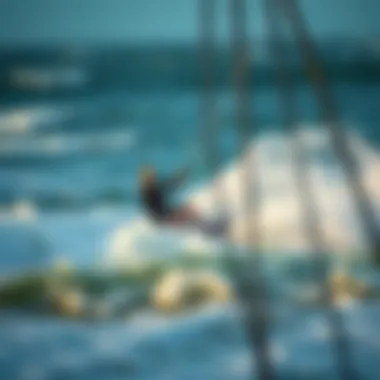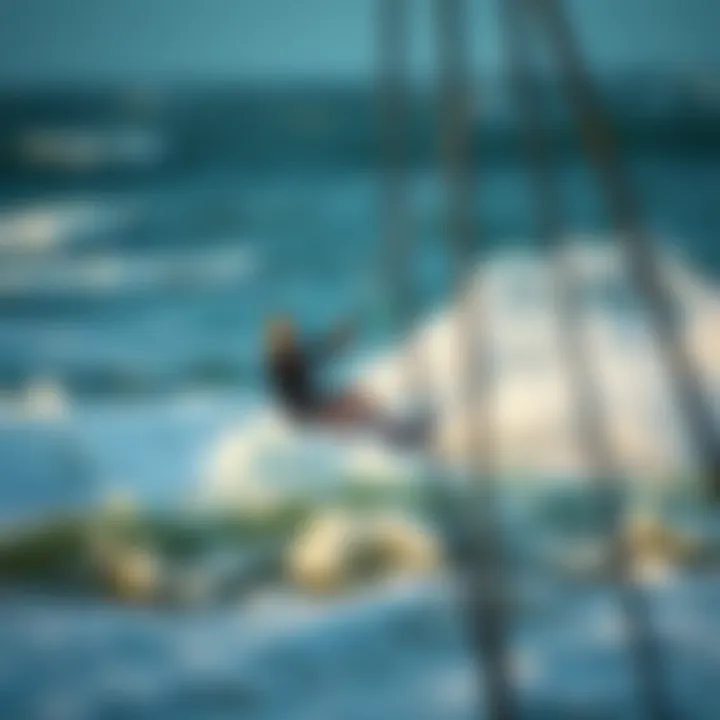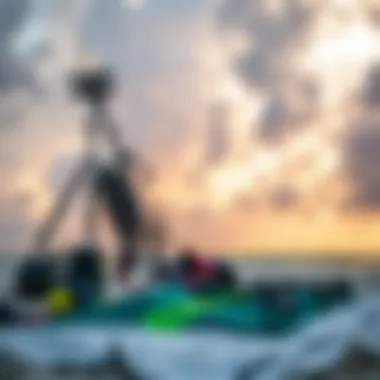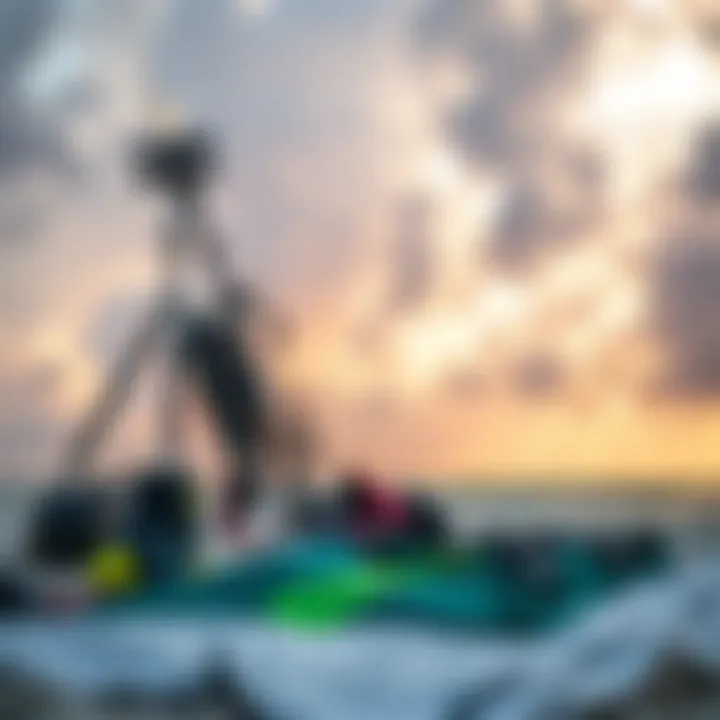Live Weather Radar Insights for Kiteboarding in New Smyrna Beach


Intro
Kiteboarding in New Smyrna Beach can be exhilarating, offering an incredible blend of speed, agility, and freedom on the water. However, navigating the elements requires more than just skill and a good board. Understanding live weather radar plays a crucial role in ensuring safety and enjoyment. Instead of facing the whims of unpredictable weather conditions, riders can utilize radar technology to gain a clearer picture of what to expect. This guide aims to illuminate the intricacies of weather radar and how it intertwines with kiteboarding, making for a smarter and more informed riding experience.
Gear and Equipment
Essential Kiteboarding Gear for Beginners
Jumping into kiteboarding can seem daunting for newcomers. Having the right gear makes all the difference. At its core, every kiteboarder needs a kite, a board, and safety equipment. The size and type of kite will depend largely on the wind conditions and the rider's weight. A suitable kite size allows for better control, especially when learning.
- Kite: A good beginner kite can range from 8 to 12 square meters. Brands like North Kiteboarding and F-One offer reliable options for newcomers.
- Board: Opt for a twin-tip board, as it facilitates learning and provides a stable footing.
- Safety Gear: A personal flotation device (PFD) and a helmet are paramount. A good harness is also essential for holding the kite line securely.
Additionally, investing in booties or sandals helps protect your feet from sharp objects or the cold water, enhancing comfort.
Advanced Equipment for Experienced Riders
For those who have grown accustomed to the thrills and challenges of kiteboarding, the right advanced gear can take the experience to another level. Here, performance and specialization come into play. Choosing specialized kites, boards, and accessories can fine-tune the riding experience based on conditions.
- High Aspect Ratio Kites: These kites are designed for speed and upwind performance, making them preferable for experienced riders.
- Directional Boards: A surfboard style board can provide a different feel, especially in wave riding conditions.
- Smart Accessories: Consider gear that integrates technology, such as GPS trackers or smartwatches that can sync real-time weather data, providing reports on wind speed and direction.
Understanding the right equipment to pair with accurate weather radar data can significantly boost the kiteboarding experience.
Techniques and Tips
Safety Practices for Kiteboarding
Safety in kiteboarding cannot be compromised. Always be aware of weather conditions before heading out. Use radar data to gauge wind speed and storm activity.
- Check Local Forecasts: Resources like the National Weather Service provide radar images that show potential storms and changing wind patterns.
- Know Your Limits: Even experienced riders should heed safety warnings. If conditions seem uncertain, postponing is often the wiser choice.
- Stay Visible: Use bright colors on your gear or kite to ensure visibility on the water, especially in cloudier or overcast conditions.
Staying informed is half the battle in kiteboarding; knowledge can mean the difference between an exhilarating experience and a dangerous situation.
Training Techniques to Improve Your Skills
Kiteboarding is a technical sport that improves with practice. Newcomers should focus on the fundamentals, while seasoned riders may want to improve specific skills.
- Practice in Safe Environments: Choose flat water areas for an easier learning curve.
- Take Lessons: Engaging with certified instructors can shorten the learning curve significantly.
- Utilize Video Analysis: Recording your sessions allows you to analyze technique and adjust accordingly.
As you gather more experiences, adjusting to varying weather will become second nature, enhancing your overall kiteboarding proficiency alongside the use of live weather radar.
Understanding Live Weather Radar
Live weather radar is a crucial tool for kiteboarders in New Smyrna Beach, offering real-time insights that can make or break a day on the water. Understanding how this technology operates empowers riders to make informed decisions that define not just their experience, but also their safety. From anticipating the sudden shifts in weather to reading wind patterns accurately, live radar systems provide kiteboarders with a sharper edge against the whims of nature.
What is Live Weather Radar?
At its core, live weather radar is a system that detects and maps precipitation, temperature variances, and other atmospheric conditions over a specific geographic area. This technology operates using radio waves that send signals to the atmosphere, bouncing back with data. For kiteboarders, understanding live weather radar means being able to interpret these signals effectively, translating them into a necessary roadmap of current weather conditions.
How Weather Radar Works
Weather radar employs a method known as radar reflection. Devices transmit electromagnetic waves, and when these waves encounter precipitation, they reflect back to the radar receiver. The time it takes for these waves to return is crucial; the radar interprets it to determine distance, intensity, and even movement of weather systems. For instance, when preparing for a kiteboarding session, knowing if there's a brewing storm or a sudden gust of wind can be the difference between a stellar ride or a reckless adventure.
Types of Weather Radar Systems
There are several radar systems in play when it comes to weather monitoring, each with its unique features and benefits.
Radar Doppler Systems
Radar Doppler systems are widely recognized for their ability to measure the velocity of rain and wind by analyzing the change in frequency of the returned signals. This feature makes them a preferred choice for kiteboarders who need to anticipate shifts in wind direction and speed. The ability to detect both precipitation intensity and movement provides vital insights into changing weather conditions.
"Radar Doppler systems are invaluable for assessing how wind conditions may shift rapidly, helping kiteboarders to stay one step ahead."


One key characteristic of Doppler radar is its capability to detect horizontal wind shifts, something that standard radar systems often miss. However, while these systems provide an expanded view of potential weather issues, they may also require some degree of understanding to interpret accurately.
Single-Polarization vs. Dual-Polarization
Distinguishing between single-polarization and dual-polarization radar systems can be vital for understanding precipitation types. Single-polarization radars only send and receive signals in one orientation, which limits their ability to classify hydrometeors. On the other hand, dual-polarization systems transmit waves in both horizontal and vertical planes.
The dual-polarization feature allows for enhanced detection of rainfall type, a major advantage for kiteboarders trying to avoid squalls. While more sophisticated, these systems can provide more accurate data regarding storm structure, leading to better predictions. However, their complexity might be daunting for those new to using radar data.
Weather Surveillance Radar
Weather surveillance radars focus primarily on monitoring large-scale weather phenomena. These systems can identify storm systems, including their size and movement, which can be critical for kiteboarders planning their sessions. Typically deployed for urban weather monitoring, they serve as an excellent guideline for kiteboarding conditions in New Smyrna Beach.
One of the important features of weather surveillance radars is their wide coverage area. This characteristic allows for the observation of significant weather events across vast distances. However, the level of detail regarding smaller, localized conditions may not be as precise, meaning kiteboarders must combine this data with other real-time tools to make well-rounded decisions.
Local Climate in New Smyrna Beach
Understanding the local climate in New Smyrna Beach is fundamental for kiteboarders and outdoor enthusiasts. The region's unique weather conditions play a significant role in shaping the kiteboarding experience, from wind patterns to seasonal fluctuations. Kiteboarders must consider the interplay between temperature, humidity, and storm systems, as these factors can greatly affect not just performance but also safety on the water.
Overview of Climate Zones
New Smyrna Beach is located in a humid subtropical climate zone, known for warm summers and mild winters. This climate fosters conditions that can be both exhilarating and challenging for kiteboarders. The area's climate is characterized by a significant amount of sunshine, which makes it attractive for outdoor sports year-round. However, kiteboarders should be aware of the seasonal changes and how they correlate with kiteboarding activities.
Seasonal Weather Patterns
Summer Heat and Humidity
Summer in New Smyrna Beach brings intense heat and humidity. Temperatures can soar, often reaching into the low 90s Fahrenheit. The humidity can make it feel even warmer, creating a sort of sticky blanket that envelops outdoor participants. While some may find this oppressive, it also creates ideal conditions for kiteboarding when there are consistent winds. The sea breezes during the late afternoon are particularly beneficial, allowing kiteboarders to enjoy sessions on the water. However, it's essential to be mindful of dehydration and heat exhaustion during peak hours.
Winter Coolness and Winds
Winter is a refreshing contrast to the sweltering summer months, with temperatures dropping into the 60s and 70s Fahrenheit. This season is marked by a shift in wind patterns, often bringing stronger winds that can enhance the kiteboarding experience. It is crucial to note that the colder air temperature might require additional gear like wetsuits. Winter winds are often more reliable, meaning that kiteboarders can plan their outings with greater confidence. However, it is the need to adjust to chillier waters that can deter some less seasoned riders.
Rainy Season Dynamics
The rainy season in New Smyrna Beach typically occurs during the summer months and can influence kiteboarding significantly. Afternoon thunderstorms are commonplace, which can bring an influx of wind but also pose risks. Understanding how to read weather patterns during this time is essential for safety. The thunderstorms can lead to sudden changes in wind direction and intensity, making it imperative for kiteboarders to stay alert and monitor radar data closely. While the rains can temporarily cool the air, the associated winds could create great riding conditions, but timing is everything.
"Kiteboarders must be weather-savvy, as the changing climate can offer both thrills and hazards."
Interpreting Weather Radar for Kiteboarding
Understanding how to interpret weather radar is crucial for kiteboarders looking to make the most of their time on the water. Unlike simply checking the weather app on your phone, live weather radar provides real-time data that can often make the difference between a perfect day on the waves and heading home early due to unexpected weather. It helps riders gauge wind conditions, determine the presence of storms, and anticipate changes in weather patterns. This section dives deep into how to effectively read radar images and identify storm systems, both of which are essential skills for anyone serious about kiteboarding in New Smyrna Beach.
Reading Radar Images
When tackling weather radar images, it’s not all about numbers and complicated meteorological jargon. For a kiteboarder, it boils down to a few key elements that can influence riding experiences:
- Color-Coding: Most radar images utilize a color spectrum to indicate intensity. Typically, light green shows light rain, while darker reds and purples indicate heavy precipitation. Knowing this can help a rider decide whether it's safe to hit the water.
- Motion and Direction: Observing how the storm systems are moving is crucial. If a storm is tracking directly towards the beach, it’s best to rethink plans and find a safe spot to take cover.
- Echo Patterns: Familiarize yourself with what different echo patterns mean. A solid band may suggest sustained winds, while scattered echoes could indicate changeable conditions. This additional insight can prepare kiteboarders for sudden gusts or calm periods, allowing for more comfortable riding.
By dedicating some time to practice reading these images, kiteboarders can enhance their skill in adapting to the ever-changing dynamics of wind and weather conditions.
Identifying Storm Systems
Spotting storm systems on the radar is a critical skill for kiteboarders. Recognizing when a storm is brewing can prevent accidents and ensure safety on the water. Here are few strategies:
- Look for Hook Echoes: A classic tornado indicator, hook echoes can also signify strong storm systems that could lead to severe weather. If this shows up on the radar, it’s wise to steer clear.
- Check for Thunderstorm Warnings: Local weather services often include alerts about potential thunderstorm activity. Such news on a radar image not only warns of rain but also indicates risks like sudden wind shifts.
- Timing is Everything: If radar shows developing severe storms, checking the projected timeline for when conditions might reach your area can help you decide whether to kiteboard now or postpone.
Being able to quickly interpret these signs not only increases one's safety but also enriches the overall kiting experience, letting riders enjoy the thrill of wind and wave without undue worry.
"Rain or shine, the ocean’s a playground. But knowing the weather makes it that much safer and more enjoyable!"
Wind Patterns in New Smyrna Beach


Understanding wind patterns is crucial for kiteboarders who wish to harness the winds effectively and safely. New Smyrna Beach, with its coastal geography and dynamic weather systems, presents unique wind conditions that can greatly influence kiteboarding experiences. The wind not only propels the kiteboarder but also affects the stability and control of the kite in the air. Knowing when and where the wind blows gives riders a tactical edge, whether they're just starting or are seasoned pros.
Regional Wind Data
Collecting reliable regional wind data is like having a trusty compass when navigating the kiteboarding seas. In New Smyrna Beach, prevailing winds often come from the east-southeast, especially during the spring and summer months. According to data from the National Weather Service, wind speeds typically range from 10 to 20 knots. However, there can be sudden gusts that catch unwary kiteboarders off guard.
Monthly averages show:
- April to October: Strong east to southeast winds
- November to March: More variable, often switching to northerly winds
This variability means that keeping a close eye on forecasts and real-time radar data can help kiteboarders avoid potential mishaps.
Common Wind Directions
Familiarity with common wind directions in New Smyrna Beach can turn average kiteboarding into an exhilarating experience. The winds generally blow from:
- East-Southeast (ESE): Best for flat water conditions. Riders can catch consistent breezes and enjoy longer sessions.
- East (E): Also favorable, especially during the summer. Typically smoother but might bring in occasional choppy water.
- Northeast (NE) to North (N): Can be trickier. Often gustier and might induce complicated conditions, particularly near the shore where geomorphology plays a notable role.
Notice that knowing where the wind comes from is just as vital as its strength; certain directions can bring turbulence, chop, or upright swells.
Effect of Coastal Topography
The coastal topography of New Smyrna Beach significantly influences local wind behavior. The presence of barriers like dunes, buildings, and vegetation can create wind shadows, dramatically affecting the wind speed and direction. For instance, kiteboarders launching from the beach might feel steady winds, but just a bit further out, the situation changes.
Consider these factors:
- Dunes and vegetation can block gusts and create turbulent air flows. Riders should be cautious as they transition from open water to coastal zones.
- Bay and inlet proximity can funnel winds. If you're near the Ponce de Leon Inlet, the wind may blow stronger due to its unique configuration.
Safety Considerations for Kiteboarding
When it comes to kiteboarding in the breezy waves of New Smyrna Beach, safety is paramount. The allure of the wind and water can sometimes cloud judgment, but being aware of weather conditions can literally make the difference between a fun day out and a dangerous situation. Kiteboarding involves the interplay of various elements—weather, wind speed, and even tides. Understanding these aspects is crucial to ensuring not just your safety but also that of others around you.
Assessing Weather Conditions
Knowing how to assess weather conditions effectively can either keep you grinning from ear to ear or have you packing up your gear before you even hit the water. Reading live weather radar is not just for nerds; it's essential for any kiteboarder who wants to thrive and survive in changing conditions. Here are some practical tips to keep in mind:
- Wind Speed: Before you set out, check the wind speed. Too high, and you might struggle to control your kite. Too low, and you may find yourself sitting on the beach twiddling your thumbs.
- Storm Systems: Always keep an eye out for approaching storm systems on the radar. A beautiful sunny day can turn dark faster than you can say "kiteboarding!". Look out for sudden shifts in wind direction, which often precedes an incoming storm.
- Temperature Changes: Temperature can also impact your comfort and safety on the water. A drop in temperature may indicate a shift in weather that could lead to rain or strong winds.
Key Insight: Keeping tabs on weather conditions before venturing out not only secures your safety but also enhances the overall kiting experience. The ocean can be unpredictable—a little preparation goes a long way.
Emergency Procedures
Accidents can happen anytime, even for seasoned kiteboarders. Having a clear emergency plan in place could be a lifesaver during critical moments. Here’s what you need to know:
- Communication: Ensure that someone on the beach is aware of your plans. Let them know where you’ll be kiting and approximately how long you’ll be out there.
- Signal for Help: If things go south, signaling for help effectively is crucial. Keep a whistle attached to your harness or board for this very purpose.
- Know Your Exits: Familiarize yourself with the area you’re kiteboarding in. Identify safe zones to head to in case of high winds or other emergencies, such as lifeguard stations or sheltered spots on the beach.
- Personal Flotation Device (PFD): Although it might not be the trendiest accessory, wearing a PFD can easily save your life in the event of unexpected mishaps.
By being aware of the surrounding weather and having a contingency plan, you’ll not only elevate your own safety but also set a standard for the kiteboarding community. With preparation and awareness, you can turn your kiteboarding adventure in New Smyrna Beach into an unforgettable experience—one filled with laughter and thrill, rather than fear and regret.
Utilizing Live Weather Radar Systems
Kiteboarding in New Smyrna Beach offers an exhilarating experience, but only if the weather cooperates. To maximize the joy and minimize the risks associated with changing conditions, utilizing live weather radar systems becomes not just an advantage, but a necessity. These systems allow kiteboarders to make informed decisions, based on up-to-the-minute weather data, ensuring a safer and more enjoyable time out on the water.
Live weather radar can provide crucial insights into wind patterns, storm movements, and overall conditions. This is especially important in coastal regions like New Smyrna Beach, where conditions can fluctuate rapidly. One moment, it might seem fine, and the next, the skies can darken with ominous clouds. The ability to access real-time data aids kiteboarders in avoiding potential danger, and it can also help plan the best times for hitting the waves.
Recommended Weather Apps
Gone are the days of relying solely on vague forecasts or asking the local shops what the weather looks like. Today, numerous apps provide live weather radar data tailored to the needs of kiteboarders. Some notable ones include:
- Windy: A favorite among outdoor enthusiasts, Windy gives an accurate snapshot of wind speed and direction using interactive radar maps. You can also view additional weather metrics like temperature and precipitation.
- Weather Underground: This app offers radar imagery along with detailed forecasts and user-submitted reports. It’s a community-driven app, which can sometimes provide localized data you won't find elsewhere.
- Kite Radar: Specifically designed for kiteboarders, this app focuses on wind conditions and also incorporates local weather stations to give tailored forecasts specific for New Smyrna Beach.
Each of these apps has its unique features, so it’s worth trying a few to find which suits your style best. By having one or two of these tools handy, you place yourself in the driver’s seat, ready to take on the elements.


Integrating Radar Data into Planning
When you're preparing for a kiteboarding session in New Smyrna Beach, the integration of radar data into your planning is key. Here’s how to effectively use this information:
- Pre-session checks: Start by checking the live weather radar for updates on wind speed and direction. This helps you determine whether it’s a go or no-go for your session.
- Monitor changes in real-time: Keep your app open while you’re on the beach. Conditions can shift unexpectedly. With radar data at your fingertips, you can adjust your plans accordingly.
- Plan around storms: If a storm is approaching, closely monitor radar images to gauge its path and intensity. This is not just for safety; it also helps in deciding the ideal time to head out once the storm passes.
- Record and analyze: Over time, keep track of which wind and weather patterns correspond to the best sessions. This will enable you to anticipate favorable conditions based strictly on your collected data.
By weaving live weather radar into your kiteboarding routine, you set yourself up not just for safer outings but also for maximizing those thrilling moments on the water. Being prepared, and knowing what's brewing above your head, pays dividends in every aspect of kiteboarding.
Common Challenges with Weather Radar
As kiteboarders, understanding the nuances of weather radar is vital. However, like any technology, weather radar has its own set of challenges that can impact our experience on the water. Addressing these challenges isn’t just about furthering our knowledge; it’s about safety and maximizing our enjoyment while kiteboarding in New Smyrna Beach. In the next sections, we’ll explore these common challenges to bolster your confidence when interpreting weather data.
Limitations of Radar Technology
Weather radar, while impressive, isn't infallible. One significant limitation lies in its dependability on atmospheric conditions. Heavy rainfall, especially, can scatter radar waves, leading to inaccurate readings. These discrepancies can be problematic, especially when a kiteboarder needs to make quick decisions based on real-time data.The radar might show a picturesque cloudy sky, while in reality, conditions could be shifting rapidly.
Another limitation involves the radar's range. In general, most weather radars have a limited radius, making it hard to capture storm systems that are far off. For kiteboarders, this means that a storm may be heading your way, but it might not show up on the radar until it’s practically at your doorstep. Similarly, small-scale phenomena, like localized wind shifts caused by land features, might not register on radar, leaving you in a bind when the winds suddenly quit or change direction completely.
"Always give the radar a second look; it might not tell the whole story."
Misinterpretations of Data
Misreading radar data can lead to dire consequences. A classic pitfall is the assumption that all rain echoes indicate precipitation that might be relevant to kiteboarding. In reality, some radar returns may be artifacts from the radar itself or simply cloud cover without significant precipitation. This misinterpretation can create a false sense of security or, conversely, an unnecessary retreat from the water when conditions may actually be flyable.
Moreover, radar imagery comes in different colors, often depicting intensity, which can be interpreted subjectively. A novice might see a dark red area and infer danger, while an experienced kiteboarder might know that some storms can break up before reaching the beach.
To navigate these obstacles effectively, combining radar information with other resources is key. Consulting weather models and local observations can provide a richer picture. It's always wise to ask a fellow kiteboarder or a local expert for their take—human insights supplement radar data in a way that technology simply cannot achieve.
In the end, while weather radar is a powerful tool for kiteboarding, being aware of its limitations and potential for misinterpretation helps kiteboarders make better decisions. Balancing this information with real-world conditions will enable a more enjoyable and safer experience on the waves.
Closure
In this guide, understanding the impact of live weather radar technology on kiteboarding activities in New Smyrna Beach has been essential for every avid kiteboarder, whether they're just starting or have many seasons under their belt. Having a grasp on weather conditions can make all the difference between a thrilling session on the water and a day spent waiting for storms to pass. Kiteboarding is a sport that dances on the edge of nature, and being aware of weather is pivotal for staying safe and enjoying the sport to the fullest.
The Importance of Weather Awareness
Awareness of daily weather conditions is not merely a matter of checking the forecast—it's about developing an intuition for the atmosphere surrounding you. A kiteboarder must recognize that wind direction and speed can shift within moments. For example, subtle changes in cloud cover can indicate shifts in wind patterns, which might bring ideal conditions or dangerous gusts. Without this awareness, one might find themselves caught off guard, compromising both safety and enjoyment.
Moreover, understanding local climate patterns, such as those typical in New Smyrna Beach, allows riders to choose the best times for their activities. For instance, familiarizing oneself with the rainy season dynamics and seasonal variations gives kiteboarders a strategic edge in planning their outings. In areas where conditions might fluctuate rapidly, being informed also helps riders identify when it's prudent to stay on land.
Future Trends in Weather Radar Technology
Technology doesn’t sit still, and this rings especially true for weather radar systems. Advances in Doppler radar technology promise improvements in real-time data collection, allowing kiteboarders to receive timely updates on changing conditions. For instance, the emergence of mobile applications that leverage weather radar data can deliver alerts directly to users based on their location, giving them that extra edge in decision-making.
Furthermore, dual-polarization radar is leading to a higher accuracy in precipitation measurement, which is a crucial factor for riders keen on avoiding stormy weather. Innovations like machine learning algorithms that predict weather patterns based on historical data can also empower kiteboarders with insights that help them foresee and adapt to changes.
In sum, a kiteboarder's journey is much smoother when backed by a solid understanding of weather radar systems and foresight into how technology might evolve in this domain. Embracing these changes keeps the sport safe and exhilarating without compromising on the thrill that every kiteboarder seeks.
Books and Publications
Books and publications play a vital role in deepening one’s understanding of weather phenomena, kiteboarding techniques, and safety measures. Recommended readings include manuals written by seasoned kiteboarders and guides that specifically address weather impacts on the sport. These resources lay out principles that govern the wind, waves, and the sky.
Examples of useful books could be:
- "Kiteboarding: The Ultimate Guide" by Jim Garvey – a comprehensive manual covering the essentials of the sport intertwined with weather considerations.
- "The Wind and Weather Guide for Outdoor Adventure" where enthusiasts can learn about interpreting meteorological signs and how they affect kiteboarding conditions.
These texts offer insights that can be overlooked in quick online searches. Immersing oneself in literature allows kiteboarders to cultivate a sharper awareness of both their craft and their environment, replacing guesswork with knowledge.
Online Forums and Communities
Online forums and communities create a bridge between novice riders and veteran kiteboarders, facilitating a treasure trove of shared experiences and real-time advice. Websites like Reddit and Facebook host groups where members trade tips on weather conditions in New Smyrna Beach or share personal anecdotes about their encounters on the wind.
These platforms often feature:
- Real-time updates: Users post immediate weather conditions they observe while kiteboarding.
- Safety discussions: Topics about how to deal with unexpected weather changes can save lives.
- Planning meet-ups: Many community members organize sessions where they can kite together, growing camaraderie while learning from one another.
Being part of such a community not only enhances knowledge but also fosters a sense of belonging that can lead to greater overall enjoyment of the sport. Online connections can offer information that may be difficult to find in traditional media, providing up-to-date and localized advice.
In summation, the value of using both books and online communities cannot be overstated. Kiteboarders who leverage these resources are often better prepared to face the waves and winds.



